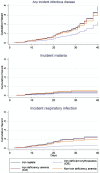Lower incidence of respiratory infections among iron-deficient children in Kilimanjaro, Tanzania
- PMID: 28852503
- PMCID: PMC5570096
- DOI: 10.1093/emph/eox010
Lower incidence of respiratory infections among iron-deficient children in Kilimanjaro, Tanzania
Abstract
Objective: We posited a trade-off in iron nutrition, with iron deficiency decreasing risk for infection by depriving infectious agents of iron while increasing risk for infection by compromising immune protection. We described associations between iron deficiency and prevalent and incident infectious disease episodes and cell-mediated immunity (CMI) among 283 children in Kilimanjaro, Tanzania. Methodology: Whole blood specimens were evaluated for hemoglobin and dried blood spots (DBS) were evaluated for biomarkers of iron deficiency (transferrin receptor) and inflammation (C-reactive protein and α1-acid glycoprotein). Prevalent and incident infectious disease episodes were identified by physician's diagnosis. CMI was evaluated as delayed-type hypersensitivity to Candida albicans (DTH-Candida). Associations between iron status and elevated inflammation, prevalent infectious disease episodes and DTH-Candida were described with logistic regression models; associations between iron status and incident infectious disease episodes were described with Cox proportional hazards models. Results: Elevated inflammation and diagnosed infectious diseases were more common among children with iron-deficiency anemia (IDA, severe iron deficiency), but not significantly so. The incidence of infectious disease was lowest among children with moderate iron deficiency (iron-deficient erythropoiesis, IDE); this pattern was most apparent for respiratory infections (aHR: 0.24; p: 0.030). DTH-Candida was not compromised among children with any degree of iron deficiency. Conclusions and implications: We observed no adverse effect of iron deficiency on CMI, but did observe patterns consistent with the hypothesis that moderate iron deficiency protects against respiratory infections and may represent a nutritional adaptation to infectious disease. This suggests that interventions targeting iron deficiency should be coupled with effective infectious disease control measures.
Keywords: evolutionary epidemiology; nutritional adaptation; nutritional immunity; optimal iron hypothesis.
Figures

References
-
- Beard JL. Iron biology in immune function, muscle metabolism and neuronal functioning. J Nutr 2001; 131:579S. discussion 580S. - PubMed
-
- Ekiz C, Agaoglu L, Karakas Z. et al. The effect of iron deficiency anemia on the function of the immune system. Hematol J 2005;5:579–83. - PubMed
-
- World Health Organization 2001. Dept. of Nutrition for Health and Development. Iron Deficiency Anaemia: Assessment, Prevention and Control: a Guide for Programme Managers.
-
- Denic S, Agarwal MM.. Nutritional iron deficiency: an evolutionary perspective. Nutrition 2007;23:603–14. - PubMed
Grants and funding
LinkOut - more resources
Full Text Sources
Other Literature Sources
Research Materials

